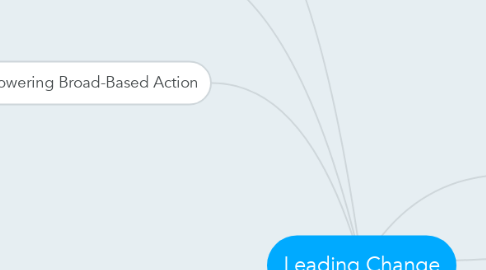
1. 2. Creating the Guiding Coalition
1.1. Putting together a group with enough power to lead the change
1.2. Getting the group to work together like a team
1.3. IS
1.3.1. working together face to face or using technology to create sense of knowing each other
1.3.2. defined roles and responsibilities
1.3.3. a project sponsor of the right authority
1.3.4. a qualified & experienced Project Manager
1.3.5. a qualified and suitable Administrator
1.4. IS NOT
1.4.1. absentee project sponsor
1.4.2. mixing project manager & sponsor role
1.4.3. recruiting late or using temporary responsibilities
1.4.4. farming sys admin or bus admin out to contractors
1.5. RF
1.5.1. roles and responsibilities
1.5.2. a kick off
1.5.3. weekly meetings and daily stand ups
1.5.4. user stories
2. 3. Developing a Vision & Strategy
2.1. Creating a vision to help direct the change effort
2.2. Developing strategies for achieving that vision
2.3. IS
2.3.1. a compelling vision
2.3.1.1. to be the best is ok, but too high level
2.3.1.2. what comes in between there and now?
2.3.2. a clear series of steps to get there with wins on the way
2.4. IS NOT
2.4.1. a vague vision
2.4.2. a changing vision/changing goal posts
2.4.3. no vision
2.4.3.1. there needs to be a reason for the change
2.4.3.2. if not why do it?
2.5. RF
2.5.1. agree user stories
2.5.2. set goals & objectives
3. 4. Communicating the Change Vision
3.1. Using every vehicle possible to constantly communicate the new vision and strategys
3.2. Having the guiding coalition role model the behaviour expected of employees
3.3. RF
3.3.1. have a comms plan
3.3.2. use marketing materials offered
3.3.3. use lots of channels
3.3.3.1. meetings
3.3.3.2. newsletters
3.3.3.3. email
3.3.3.4. involve wider team in design and UAT
4. 5. Empowering Broad-Based Action
4.1. RF
4.1.1. being prepared to use best practice
4.1.2. using the change model in RF
4.1.3. going for OTB
4.1.4. reviewing each change against the objectives
4.1.4.1. if it doesn't help to get to objective in 1 step
4.1.4.2. don't do it
4.2. Getting rid of obstacles
4.3. Changing systems or structures that undermine the change vision
4.4. Encouraging risk taking and nontraditional ideas, activities, and actions
5. 8. Anchoring New Approaches in the Culture
6. Leading change by John P. Kotter
6.1. is the classic text on managing change
6.2. it is one of those books that most managers will have read or be using guidance from with out knowing.
6.3. it's recommendations are widely known if not necessarily always understood
6.4. case in point is establishing a sense of urgency which can be taken to mean setting a really tough
6.5. deadline
6.6. although first published in xx this book still represents simple actionable advice relevant in today's online digital world
7. 1. Establishing a Sense of Urgency
7.1. Examining the market and competitive realities
7.2. Identifying & discussing crises, potential crises, or major opportunities
7.3. IS NOT
7.3.1. setting arbitary deadlines
7.3.2. setting deadlines that are very hard to achieve
7.3.3. threatening or bullying
7.4. IS
7.4.1. Sharing the goals & objectives
7.4.2. putting the project in context
7.4.3. saying what finished what looks like
7.4.4. answering 'what does this mean for me?'
7.4.5. explaining why the change is needed
7.5. RF
7.5.1. understanding digital enterprise management
7.5.2. knowing current issues and knowing where to get to
7.5.3. setting a timeline that is tight, but achievable
